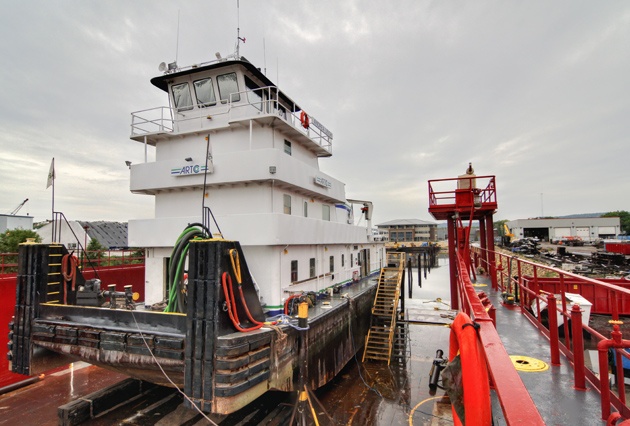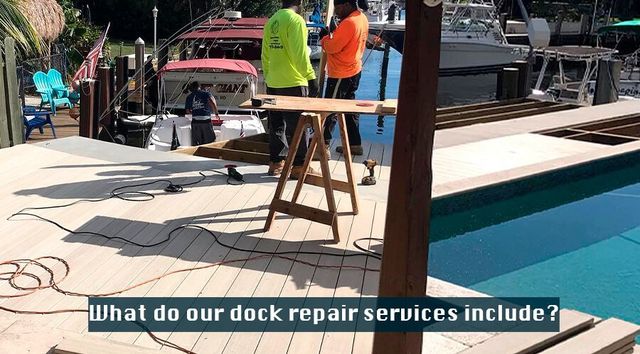Exactly How to Address Common Dock Fixing Issues for Safe Water Tasks

Identifying Common Dock Issues
Determining common dock issues is vital for keeping the capability and safety and security of your beachfront residential or commercial property. Regular evaluations can assist uncover issues prior to they become severe, making certain both the longevity of the dock and the safety of those who utilize it. One prevalent problem is rusty or loose bolts. In time, screws, bolts, and various other bolts can come to be loosened due to consistent exposure to water and weather components, resulting in architectural instability.
An additional usual issue is the destruction of flotation tools. These devices are essential for keeping the dock resilient, and any damages or punctures can trigger the dock to checklist or sink. Frequently checking for leaks or water logged drifts can preempt much more substantial issues.
Additionally, algae and barnacle build-up on the dock's surface area can create slippery and harmful problems. This biofouling not just poses a risk to individuals yet can also accelerate the deterioration of the dock materials.
Finally, evaluating for signs of rust on metal elements is crucial. Rust can jeopardize the stability of the dock's structure, making it unsafe. By routinely determining these usual dock issues, you can make sure that your dock continues to be practical and safe and secure for several years ahead.
Repairing Rotting Wood
When attending to the issue of decomposing timber on your dock, it is crucial to act promptly to avoid further deterioration. Begin by thoroughly examining the entire framework to recognize all influenced locations. Utilize a screwdriver to probe the wood; if it sinks in conveniently, the timber is most likely decomposed and requires immediate interest.
Be sure to reduce back to healthy, solid timber, guaranteeing you get rid of all compromised material. After elimination, deal with the staying wood with a wood preservative to stop future rot.
Following, change the removed sections with marine-grade lumber or pressure-treated timber, which are much more immune to water damage. Secure the new items with stainless-steel or galvanized fasteners to avoid deterioration. Furthermore, applying a water-proof sealer to the brand-new wood can provide an additional layer of protection.
Securing Loose Boards
Just how do you ensure your dock continues to be risk-free and functional for all its users? One essential facet is securing loosened boards, click here for more info which can or else position considerable threats. Loose boards not only enhance the threat of tripping but can additionally jeopardize the structural integrity of the whole dock.

For reinstallation, use galvanized or stainless steel screws, as these products supply superior resistance to corrosion in marine settings. Guarantee the screws are long sufficient to pass through deep right into the underlying support framework, but not so lengthy that they extend through the dock's surface area. Pre-drilling pilot holes can help protect against the timber from splitting.
Lastly, keep a routine examination timetable to determine and address any kind of new issues without delay. i was reading this By safeguarding loose boards efficiently, you add to the total security and longevity of your dock, making it a trustworthy platform for water activities.
Maintaining Unsteady Pilings
Guaranteeing the stability of unsteady pilings is paramount to maintaining a secure and useful dock. Unsteady pilings can endanger the entire framework, positioning substantial risks to users and potentially causing costly repair services. The very first step in maintaining these vital parts is a detailed evaluation. Check out the pilings for indications of rot, damages, or shifting. Utilize a degree to check for vertical placement and ensure they are driven deep sufficient into the substratum to give sufficient assistance.
If the pilings are located to be unpredictable, one effective method for reinforcement is making use of extra supporting. Cross-bracing with dealt with lumber or galvanized steel can considerably enhance stability. Support the dental braces securely to both the pilings and the dock framework to disperse lots equally.

Routine maintenance and periodic reassessment of the pilings' security are critical to ensuring long-term dock safety and capability.
Changing Rusty Equipment
Resolving unstable pilings is simply one facet of keeping a dock's integrity; an additional vital concern is changing rusty equipment. Over time, direct exposure to moisture and salt can bring about the oxidation and rust of screws, braces, and screws, jeopardizing the entire structure's safety and security. Routine evaluation for corrosion is vital, particularly after serious weather or seasonal modifications.
When rusty equipment is determined, instant action is required. Begin by choosing marine-grade stainless-steel or galvanized hardware, both developed to stand up to the rough aquatic atmosphere. Make certain that you have the suitable tools, such as wrenches and screwdrivers, to safely remove the old, rusty items without causing additional damages to the Discover More Here dock.
After removing the rusty hardware, completely tidy the affected areas to get rid of any kind of recurring rust or debris. Apply a rust-inhibiting guide to revealed steel surface areas before setting up the brand-new equipment. Tighten all components securely to avoid future helping to loosen, and occasionally inspect the fittings to guarantee continuous stability.
Replacing rustic hardware not only prolongs the dock's life-span yet also substantially boosts the safety of water activities. By proactively managing rust, you shield both the framework and its users, making certain a pleasurable and protected waterside experience.
Final Thought
Regular evaluations and maintenance are necessary to attend to typical dock repair work issues and ensure risk-free water tasks. Such positive measures add to the overall security and functionality of dock frameworks, fostering a safe and secure setting for water-based activities.
Making sure the security of water activities hinges dramatically on the correct maintenance and repair work of anchors (Dock Repairs). These gadgets are important for keeping the dock resilient, and any type of damage or slits can create the dock to checklist or sink. By regularly determining these common dock problems, you can make certain that your dock continues to be useful and protected for years to come
Ensuring the security of unsteady pilings is extremely important to keeping a useful and safe dock.Regular assessments and upkeep are vital to resolve common dock repair work problems and make certain safe water activities.